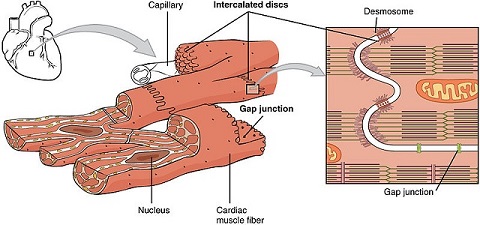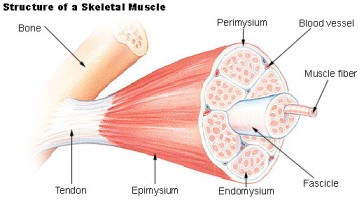The Musculoskeletal system is the muscle system and skeletal system working in conjunction to help movement, support and blood flow in the body. Muscles contract and relax by using ATP, this is produced when oxygen is transported to muscles by hemoglobin for respiration to occur. Muscle activity is regulated by the nervous system where neurotransmitters released by the pre-synaptic membrane bind to the post synaptic membrane of motor neurons – causing a release of calcium ions, which pass a threshold to produce a muscle twitch.There are three types of muscles involved: smooth, cardiac and skeletal.
Smooth muscles are controlled by the parasympathetic nervous system, which is in control of involuntary activities like digestion. They are present in the walls of hollow vessels like the small intestine, bladder, or even blood vessels – called smooth muscles because they lack striated muscle fibers in their structure.

Image Credit: Wikimedia Commons.
Cardiac muscles are found only in the heart, they are classified as involuntary muscles and controlled by the autonomic nervous system. The muscles are self-contracting and thus never ‘tire’, they are woven in an interlocking lateral Y-shape. A defining feature is the presence of intercalated disks, which pass action potentials from one fiber to another in waves.

Image Credit: Wikimedia Commons
Skeletal muscles are connected to the human skeleton by tendons, theses muscles are voluntary and are controlled by the somatic nervous system. Skeletal muscles commonly link two separate bones, during contraction the bones come together and during relaxation the bones move apart. These muscles are striated in structure and are called ‘myofibrils’, these contain repeating units of actin and myosin which are responsible for the contraction mechanism.

Image Credit: Wikimedia Commons.
Title Image Credit: Wikipedia
© BrainMass Inc. brainmass.com April 19, 2024, 6:54 pm ad1c9bdddf